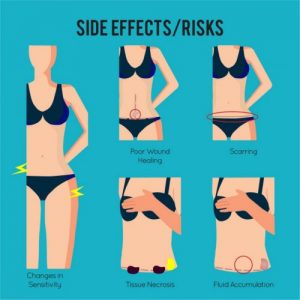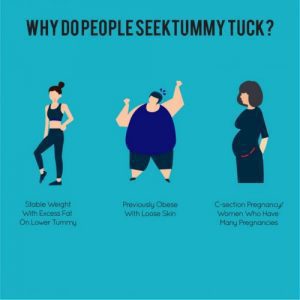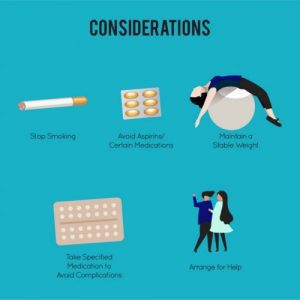Since it’s hot all year round in Malaysia, it’s normal for us to be doing water activities such as the swimming at the beach. However not all of us are confident to bare it all in a bikini. Despite doing exercise and diet, you feel that your tummy just isn’t responding to all the sit-ups, you may want to consider an abdominoplasty, or commonly called “tummy tuck”.
What is Tummy Tuck?
A tummy tuck surgery improves the appearance of the abdomen. During the procedure, excess skin and fat are removed from the abdomen surgically. In most cases, the connecting tissues in the abdomen are tightened with sutures as well. The remaining skin will be repositioned to create a more toned look. People mainly opt to do a tummy tuck to get rid of excess skin that’s accumulated around the belly button or on the lower abdominal area.
Types of Tummy Tuck
There are 3 components of the torso that can be addressed with a tummy tuck:
Skin: loose or wrinkled skin can result from pregnancy, aging or weight loss
Fatty Tissue: fat deposits can be caused by aging, childbearing, hormones or genetics
Abdominal Muscles: many patients suffer from abdominal muscle separation (diastasis) or stretching (laxity) which cannot be corrected through exercise alone.
Beverly Offers 3 Types of Tummy Tuck Procedures:
Mini Tummy Tuck: Patients who have good upper abdominal skin and muscle tone are suitable for mini tummy tuck. Problems are limited to the bottom half of the stomach and may include an amount of loose skin or excess fat located below the belly button.
The mini tummy tuck surgery is performed through a smaller four to 8 inches incision along the bikini line. A small amount of excess skin may be removed through the incision and the surgeon may target small pockets of fat using liposuction. In some cases, the lower abdominal muscle may be tightened.
Normal Tummy Tuck (180 Degree): often just referred to as “tummy tuck” or “lipoabdominoplasty” is the most frequently performed out of the abdominal surgeries. If you have loose skin, stretched-out muscles, or excessive abdominal fat, a full tummy tuck may be the best option if you want a flat and firm abdomen. This procedure can shave two to four inches from a patient’s waistline. An incision is made that spans from the hip bones known as “full bikini line incision”. The surgeon works to remove all the excess fat and skin from the lower abdomen, and may also perform liposuction on the upper abdomen. Finally, the abdominal muscles are strengthened and repaired. Typically, after surgery is completed the resulting scar can be hidden by a bikini.
Extended Tummy Tuck (360 Degree): a.k.a “fleur-de-lis abdominoplasty” this is recommended for patients who have excess skin throughout the entire abdomen and trunk, particularly if they have trouble spots in the upper abdomen, lower chest and back.
During this surgery, the surgeon will perform a horizontal incision along the bikini line (similar to full tummy tuck). In addition, a full vertical mid-line incision will be utilized to perform a more complete removal of excess skin on the abdomen, lower chest and back. This surgery is suitable for patients who have severe loos skin on the torso, the extended tummy tuck can produce a more dramatic before-an-after result than a full tummy tuck.
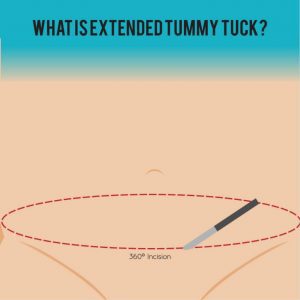
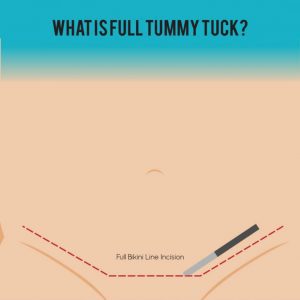
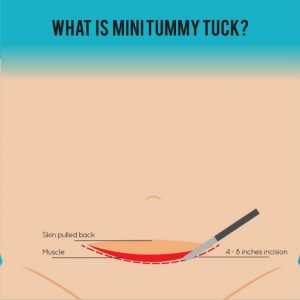
Why Do People Seek Tummy Tuck Instead of Liposuction?
Tummy tuck is not the same as liposuction, although you may opt to get liposuction along with your tummy tuck procedure. Tummy tuck surgery is considered a major surgery, make sure you know the facts before you go ahead with it.
The main reason people choose to have a tummy tuck is due to excess loose skin and fat in their abdominal area. You should be in good health before considering a tummy tuck, you may find surgeons that ask you to exercise before you get the surgery done. You are suitable for a tummy tuck if:
- You have excess skin that’s accumulated at the lower half of your tummy below the belly button
- You have a weak lower abdominal wall
- Liposuction didn’t adequately improve the appearance of your abdomen
- Women who have had several pregnancies may find the procedure useful for tightening their abdominal muscles and reducing skin
- You previously have C-section and have scarring. If you have done C-section previously, the surgeon may be able to incorporate your existing C-section scar into your tummy tuck scar.
- A tummy tuck is also an option for men or women who were previously obese but have excess loose skin around the belly
- A tummy tuck can also be done with another cosmetic procedure, such as Breast Surgery.
A Tummy Tuck is not suitable if:
- You plan to lose a significant amount of weight
- Might consider future pregnancy, postpone a tummy tuck if you’re not done having children
- Have severe chronic condition, such as heart disease, diabetes or irritable bowel syndrome
- Have a body mass index that’s greater than 30
Considerations
Before you go ahead with a tummy tuck, you will need to:
Stop Smoking. Smoking decreases blood flow in the skin and can slow the healing process. Smoking also increases the risk of tissue damage. If you are a smoker, the surgeon will recommend that you stop smoking before surgery and during recovery.
Avoid certain medications. There are certain types of medications that can increase bleeding, as such the surgeons will advise you to stop taking aspirin, anti-inflammatory drugs and herbal supplements before the surgery.
Maintain a stable weight. Ideally you should maintain a stable weight for at least 12 months before having tummy tuck. If you are severely overweight, the surgeon will recommend that you lose weight before the procedure. Significant weight loss after the procedure can diminish you results. Eat a well-balanced and complete meal. Don’t try drastic diets before the surgery.
Take medication to prevent complications. Shortly before the surgery, you will need to take anti-coagulant to prevent blood from clotting.
Arrange for help during recovery. Before the surgery, get your home ready. You will need ice packs (to help with swelling), loose, comfortable clothes that can be easy to pull on and off, petroleum jelly and a handheld shower head with bathroom chair. You should also make plans for someone to drive you home after your stay at the ward. Ideally, get someone to stay with you during your first night of recovery at home
Before Tummy Tuck Surgery
Great you’ve decided to get a tummy tuck. So where do you start? First, get a consultation with a plastic surgeon and discuss your expectations with them. It’s important to be honest with the surgeon about why you want to do the surgery, what you expect in terms of appearance after the procedure. The doctor will share about the risks and the benefits of the procedure. You may ask your surgeon to show you some before and after photos to see the results.
The team will also review your medical history, be prepared to answer questions about your current and past medical conditions. You should be truthful with the surgeon and share about any medication you are taking, have taken recently, or any medication that you are allergic to. If your desire for a tummy tuck is related to weight loss, your surgeon will likely ask detailed questions about your weight gain or loss.
Either the surgeon or nurses will do a physical examination to determine what are your treatment options. The doctor will examine your abdomen and may take some pictures for medical record.
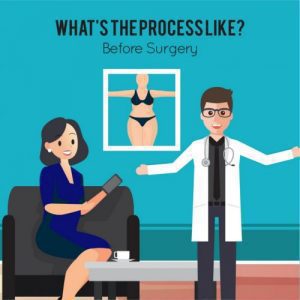 During Tummy Tuck Surgery
During Tummy Tuck Surgery
The tummy tuck surgery will be done in Beverly’s facilities. During the tummy tuck procedure, you will be under general anaesthesia which makes you completely unconscious and unable to feel pain. This will ensure that the patients are comfortable during the surgery. During the surgery you will be given antibiotic to prevent any infection.
Your plastic surgeon will then make incisions to remove most of the skin and fat between your belly button and pubic hair in a horizontal oval or elliptical shape. The fascia, which overlies the abdominal muscles will be tightened with permanent sutures.
The plastic surgeon will then reposition your skin around the belly button. Your belly button will be brought out through a small incision and sutured in its new position. The incision from hip to hip above the pubic hair will be stitched together and will leave a scar that falls along the natural crease within the bikini line. The procedure can take from 1 to 5 hours.
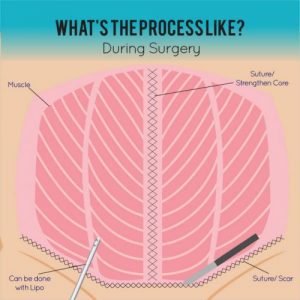 After Tummy Tuck Surgery & Recovery
After Tummy Tuck Surgery & Recovery
After the tummy tuck surgery, your abdominal incision and your belly button will likely be covered with surgical dressing. Small tubes might be placed along the incision site to drain any excess fluid or blood.
Your bed will be positioned to keep your upper body slightly raised and your knees at an angle for the first few days after surgery. The Beverly team will also help you to walk as early as the first day after a tummy tuck to help prevent the formation of blood clots.
You’ll likely feel moderate pain, which will be controlled by pain medication given by the nurses. It’s normal to experience swelling in the surgical area for up to 6 weeks, in some cases it could take up to 3 months to resolve. You may also feel numbness, bruising and tiredness during the recovery period.
Drains may be left in place after the surgery for a few days, either the surgeon or nurses will show you how to take care and empty the drains. You will also need to continue with antibiotic as long as the drains are in place. The surgeon may also prescribe anticoagulant for several days after the surgery.
You will need to wear a supportive abdominal garment (abdominal binder) which you can get from our friendly staff at our centre. You will need to wear it for about 6 weeks after the surgery, this will help prevent fluid build-up and provide abdominal support while you heal.
It’s important to take care in moving and to avoid positions that strain your incision lines during the first 6 weeks after a tummy tuck surgery. Motions such as quickly bending at the waist may cause the wound to reopen, so take care to move cautiously. You may need to take up to one month off work after the surgery to ensure proper recovery. In addition, you will need to schedule a follow-up with your surgeon for the next year.
 Maintenance
Maintenance
It’s important to maintain a healthy diet and exercise to help maintain your results. You will never look at food the same. Most probably, you wouldn’t want to do anything that might alter or even reverse your tummy tuck results. Remember to talk to our plastic surgeon about the sustained commitment required after this procedure.
 Possible Side Effects / Risks
Possible Side Effects / Risks
Like any other type of surgery, tummy tuck poses a risk of bleeding, infection and an adverse reaction to anaesthesia. There’re also other risks you should consider, including:
Fluid Accumulation
Drainage tubes left in place after surgery can help to reduce the risk of fluid accumulation beneath the skin (seroma). The surgeon may also remove fluid after surgery with a needle and syringe.
Poor Wound Healing
Areas along the incision may heal poorly or begin to separate. You will need to contact your surgeon immediately if the are begins to separate. You will also be given antibiotics during and after surgery to prevent any infection.
Scarring
The incision scar from a tummy tuck is permanent, but is placed along the easily hidden bikini line. The length and visibility of the scar will vary from person to person. The surgeon will recommend some creams and ointments to use to help with scarring. After the recovery period, you can talk to your surgeon about minimizing scarring with laser therapy.
Tissue Necrosis
During a tummy tuck, fatty tissue deep within your skin in the abdominal area might get damaged or die. Smoking increases the risk of tissue necrosis. Depending on the size of the area, tissue might heal on its own within weeks or require a surgical touch-up procedure.
Changes in Sensitivity
During a tummy tuck, the repositioning of your abdominal tissues can affect superficial sensory nerves in the abdominal area and sometimes in the upper thighs (though it’s quite rare). You’ll likely feel some reduced sensation or numbness. This usually diminishes in the months after the procedure.
Finding a certified cosmetic surgeon is not enough. Getting a board-certified cosmetic surgeon who has plenty of experience in your procedure of choice is critical to getting the results you desire. Drop us a message and we will ensure you are being served and treated well.
